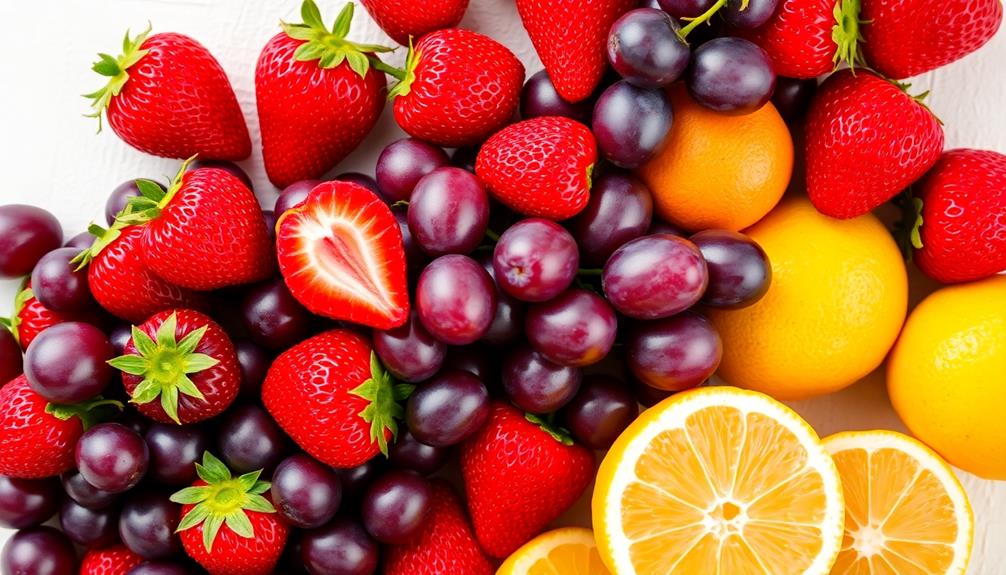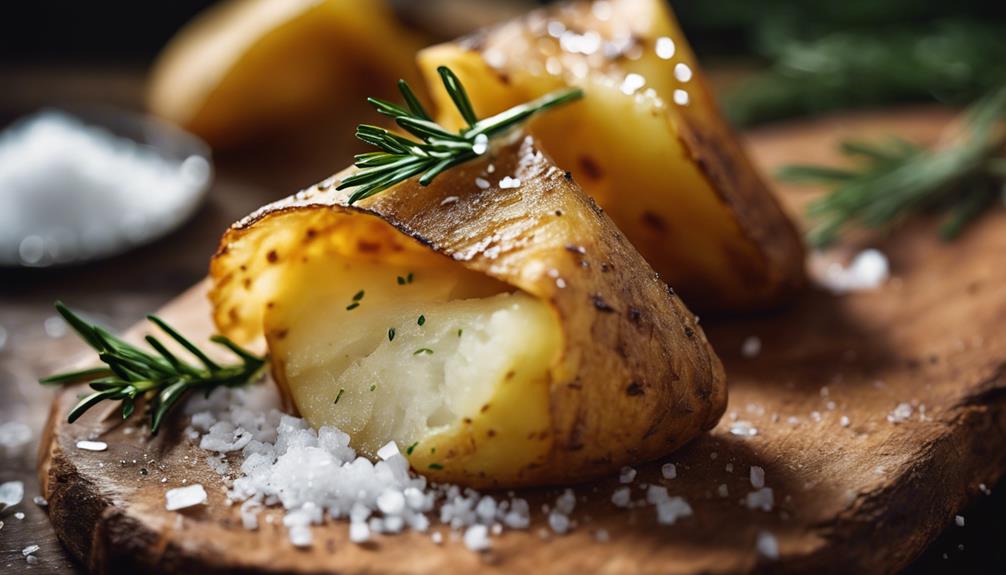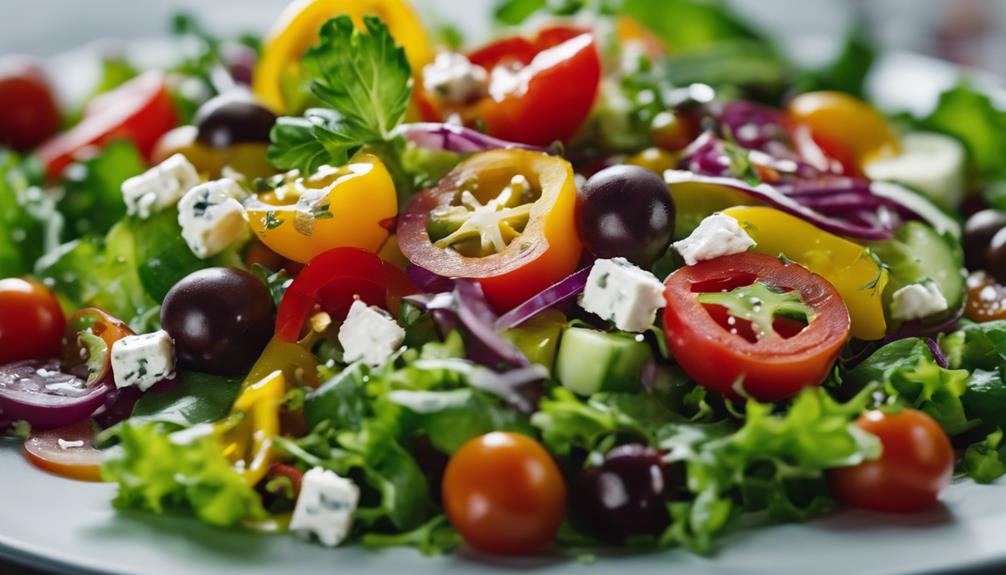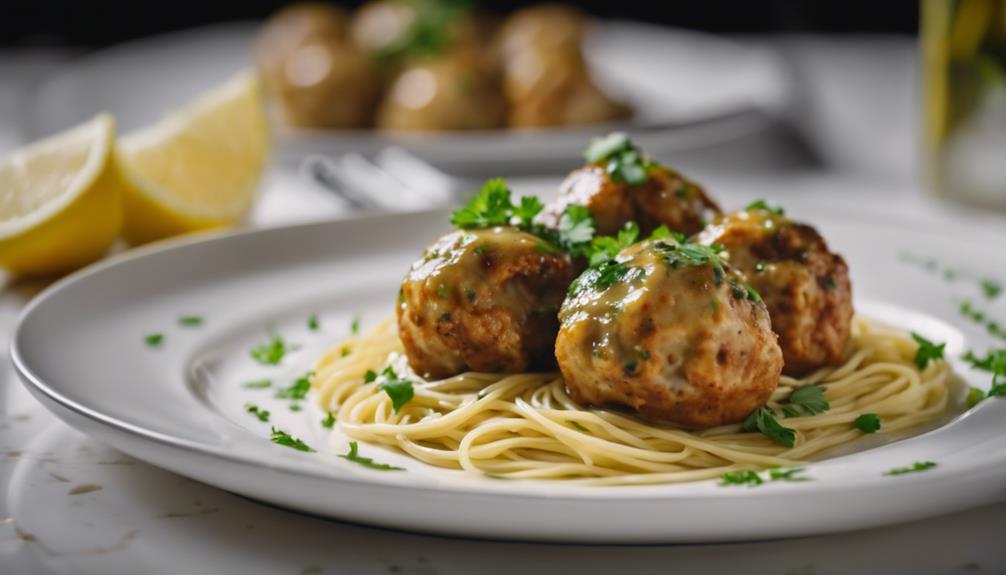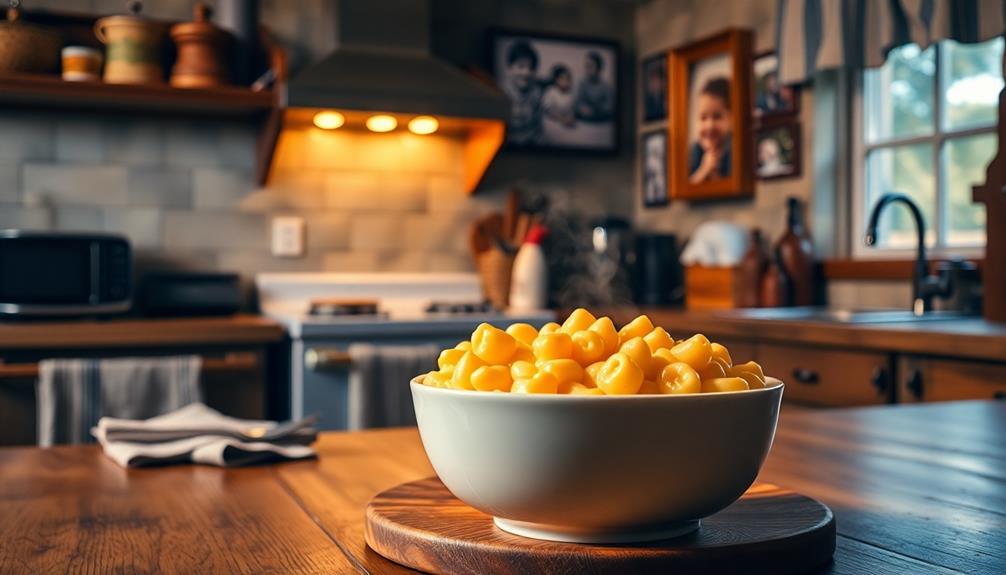Color plays an important role in how you perceive flavor, shaping your expectations even before you take a bite. Bright colors often signal sweetness and freshness, enhancing your anticipation. Conversely, dull or mismatched colors can lead to disappointment or aversion. Your brain links vibrant hues to stronger flavors, while cultural influences further alter these associations. Off-colors may even suggest spoilage, impacting your enjoyment. Essentially, the color of your food can fundamentally change your flavor experience. If you're curious about the nuances of this relationship, you might find more fascinating insights ahead.
Key Takeaways
- Food color significantly influences taste expectations, with bright colors often suggesting sweetness and freshness.
- Color associations with flavor vary across cultures, affecting how flavors are perceived globally.
- Visual cues, particularly color, play a crucial role in shaping flavor perceptions before tasting.
- Off-colors can lead to assumptions of spoilage, negatively impacting the overall dining experience.
- Consumer expectations regarding color strongly influence food acceptance and purchasing decisions.
Psychological Effects of Food Color
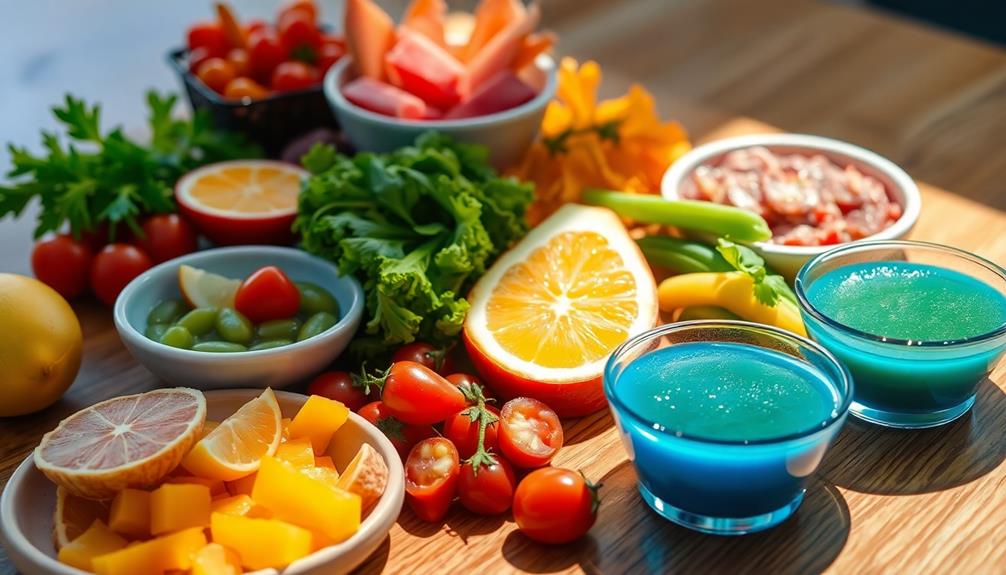
Food color plays an essential role in shaping your expectations about taste and quality. The vibrant hues of food products serve as powerful visual cues that markedly influence your flavor perception. For instance, dishes like Red-Braised Pork Belly showcase rich colors that enhance the anticipation of their deep flavors. Bright colors often suggest sweetness and freshness, creating positive expectations before you even take a bite.
However, mismatched colors and flavors can confuse your taste perception, leading to disappointment. For example, if you see a cherry-flavored drink that's orange, it may affect your acceptance and enjoyment of the product.
The psychological effects of color extend to your appetite as well. Studies show that when you're presented with foods in unexpected colors, like colored steak or fries, your desire to eat can diminish. This highlights how vital color is in influencing consumer behavior.
When selecting fruits and vegetables, you likely gravitate toward those with vibrant colors, associating them with higher quality and better taste. Ultimately, the colors you encounter in food products shape not just your expectations but also your overall eating experience. Understanding these dynamics can empower you to make more informed choices about the foods you enjoy.
Flavor Associations by Color
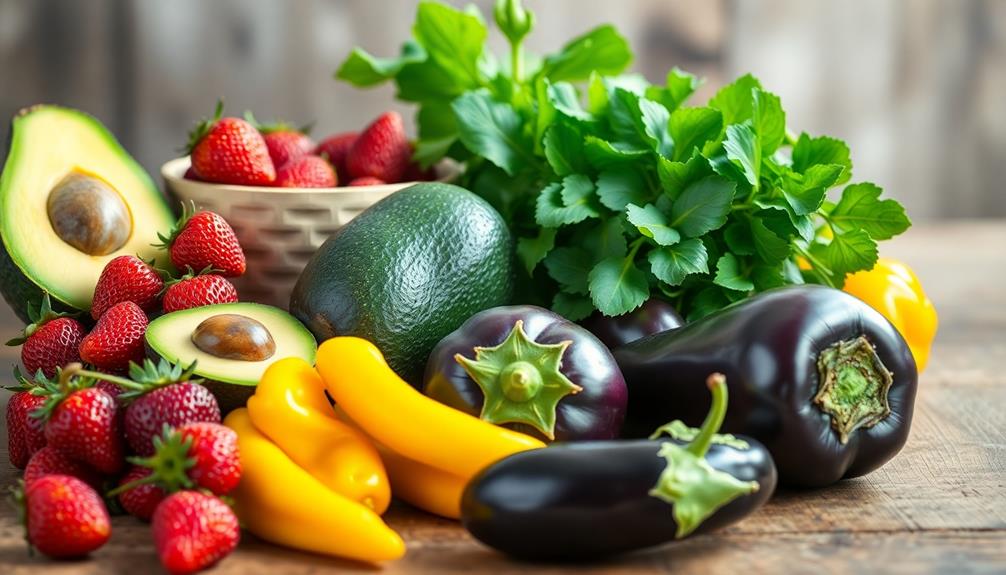
You probably don't realize how much color shapes your expectations about flavor. For instance, bright red foods often signal sweetness, while darker colors can hint at bitterness.
This is particularly evident in dishes from various cultures, where the presentation and color of food play a significant role in the overall dining experience. In Brazilian cuisine, for example, the vibrant colors of dishes like Cuscuz Paulista not only attract attention but also indicate the diverse flavors and ingredients used.
Plus, cultural differences can twist these associations even further, creating a complex web of flavor perceptions based on color.
Color and Taste Expectations
When you glance at a plate of colorful dishes, your mind instantly starts forming expectations about their flavors. The colors of food play an essential role in shaping your taste perceptions. For instance, bright red foods often signal sweetness, while darker colors can lead you to expect bitterness. This interplay between color and taste creates sensory expectations that guide your eating experience.
The vibrant colors of dishes like Agnolotti or Pasta Alla Norma can evoke feelings of excitement and anticipation, further influencing how we perceive their flavors.
Moreover, the intensity of food colors can influence taste perception; more vibrant colors typically correlate with stronger flavors. If you encounter a cherry drink that appears orange, you might misidentify its flavor due to this mismatch, highlighting the crossmodal effects of color on taste.
The visual aspects of food not only affect how you perceive its flavor but also your judgments about its quality. Bright, appealing colors usually indicate freshness and higher quality, making the dish more enticing.
Cultural variations also come into play, as different cultures associate specific food colors with unique flavor profiles. Ultimately, the colors on your plate don't just look good; they set the stage for what you expect to taste.
Cultural Flavor Associations
Color associations with flavor vary greatly across cultures, shaping how you perceive taste based on visual cues. These cultural flavor associations greatly influence your expectations and experience with food.
For instance, while red often suggests sweetness in many Western cultures, it might evoke different flavors elsewhere. This is particularly evident in traditional Japanese sweets like Dorayaki (Red Bean Pancake), where the bright color of the pancakes enhances the perception of their sweet red bean filling.
Here are some key points about how color influences flavor perception:
- Bright Colors: Colors like red and yellow are associated with sweetness and energy, making them more appealing.
- Darker Colors: Shades such as brown and black typically evoke bitterness, affecting your flavor profiles.
- Cultural Variability: White can be seen as sweet in some cultures but bland in others, illustrating how different cultures interpret colors uniquely.
- Atypical Colors: When faced with foods in unusual colors like blue or green, you might struggle with flavor identification due to strong cultural ties to traditional associations.
These sensory expectations shape your overall food experiences, highlighting the importance of visual information in how you identify and enjoy flavors across different cultures. In Western cultures, the color and presentation of food are thought to enhance the perceived taste and quality of a dish. In contrast, Asian cultures often prioritize the balance of flavors, textures, and colors to create a harmonious dining experience. This emphasis on visual appeal and taste perception demonstrates how the umami taste explained by a combination of visual and sensory cues influences our enjoyment of food.
Visual Cues Influence Perception
Drawing on vibrant hues, visual cues notably shape how you perceive flavor. Color acts as a primary sensory cue, influencing your expectations of taste greatly. For instance, empirical evidence shows that bright red foods are often perceived as sweeter than those of other colors. When you see a cherry drink that's orange, you might experience flavor confusion, expecting something different than what you taste.
In Indian cuisine, dishes like Mushroom Masala often present vibrant colors that enhance the overall dining experience and flavor anticipation.
Colors evoke specific flavor associations, with pink and red usually linked to sweetness, while brown suggests bitterness. This relationship highlights how color intensity affects your expectations; more vibrant colors often lead you to anticipate stronger flavors.
Additionally, cultural influences play an essential role in flavor-color associations. Depending on your background, the same color might represent various flavors, impacting your overall taste perception.
Your experience of flavor is therefore a complex interplay of visual cues and expectations. By understanding how these elements work together, you can enhance your culinary experiences and better appreciate the role of color in flavor perception.
Ultimately, the way you perceive taste is deeply intertwined with the colors around you, shaping your overall enjoyment of food and drink.
The Role of Off-Coloring

When you see food with off-colors, your mind might jump to spoilage or poor quality, leading to an instinctive avoidance.
This disconnect between what you expect to see and what's actually there can ruin your flavor experience.
For instance, a vibrant green soup made from nutritious nettles may be more appealing than a dull brown one, even if the flavors are equally delightful.
Understanding how these color perceptions affect your choices can shed light on why certain products succeed or fail in the market.
Consumer Color Expectations
Consumer color expectations play an essential role in how we perceive food, often determining our acceptance or rejection of a product based on its appearance. For instance, dishes like Muamba De Galinha from Angola showcase vibrant colors that enhance their appeal, making them more enticing to consumers.
When it comes to flavor perception, off-coloring can create significant barriers. You might find that your preferences lean towards certain colors, and when those expectations aren't met, your sensory experience can be negatively impacted.
Here are four key points about consumer color expectations:
- Natural vs. Artificial: Many consumers prefer natural colors in food, as artificial hues can misalign with anticipated flavor.
- Quality Association: Off-coloring often leads to assumptions about spoilage, even if the product is safe to eat.
- Taste Perception: Studies show that abnormal colors can trigger avoidance reactions, dramatically reducing acceptance.
- Health Trends: Consumers are increasingly leaning towards products without artificial colorings, balancing health concerns with visual appeal.
Understanding these aspects can help you choose products that align with your expectations, enhancing your overall eating experience.
The interplay between color and flavor perception is crucial, shaping not just what you eat but how you perceive its taste.
Spoilage and Off-Colors
Spoilage and off-coloring in food can create immediate red flags for consumers, often leading to an instinctive rejection of products that appear unappetizing. Your color perception plays a vital role in this reaction. Natural off-coloring, like browning in fruits and vegetables, triggers strong avoidance behaviors, as these visual cues signal spoilage. You might associate such colors with decay, making you less likely to choose them.
For instance, in Ethiopian cuisine, dishes like Yeselata can be negatively impacted by any off-coloring, as fresh and vibrant ingredients are essential for appealing presentation and flavor. Artificial off-coloring presents another challenge, as it conflicts with your expectations of what food should look like. This discrepancy can create negative consumer perceptions, leading you to view these products as unnatural or even unhealthy. When you encounter off-color foods, it often sparks negative flavor perceptions, making you question their quality.
Successful food products align with consumer expectations regarding color to enhance food acceptance. If a product's packaging fails to meet these visual standards, it risks significant declines in sales.
Nowadays, many consumers prefer options without artificial coloring, further underscoring the importance of color in food marketing strategies. By understanding the role of spoilage and off-colors, you can make more informed choices in the grocery aisle.
Neurobiology of Color and Taste
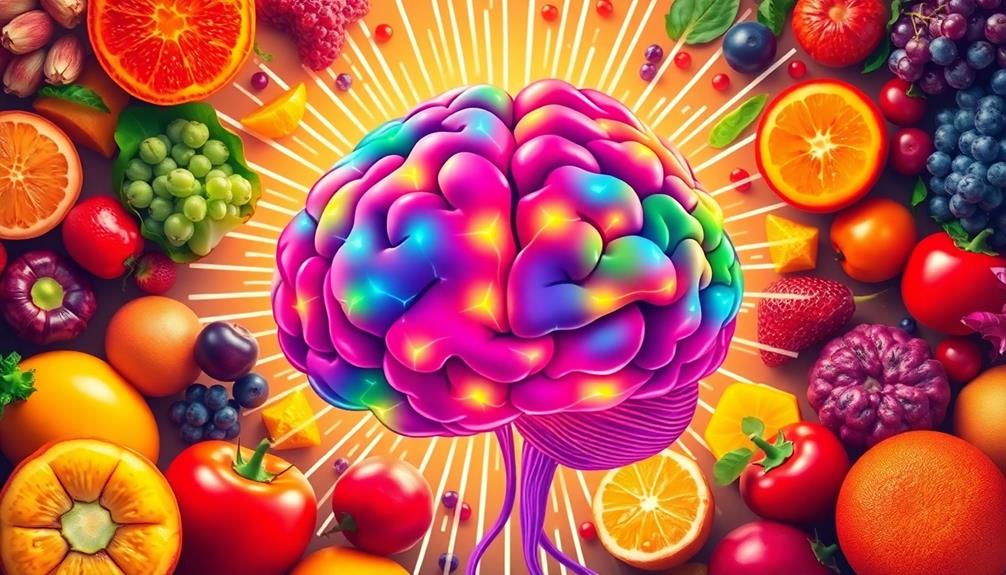
A significant portion of your brain, over 50% of the cerebral cortex, is dedicated to visual processing, highlighting the essential role color plays in shaping your flavor perception even before you take a bite.
The relationship between color and taste is intricate, influenced by your expectations and sensory perception. For example, the vibrant colors of dishes like Turkey Soup can evoke a sense of warmth and comfort, enhancing the overall dining experience.
Here are four key points about this connection:
- Color Expectations: Bright colors, like red, often lead you to expect sweeter flavors, while unusual colors can diminish your appetite.
- Neuroimaging Studies: Research shows that visual clues can bias your taste perceptions, altering your enjoyment of food.
- Flavor Misidentification: Studies reveal that when color mismatches occur, up to 70% of people misidentify flavors, like perceiving grape taste under red lighting.
- Color Intensity: The saturation of a color correlates with perceived flavor strength; brighter foods are frequently rated as having more intense flavors.
Understanding the neurobiology of color and taste helps you appreciate how your brain processes visual cues, influencing your overall dining experience.
This interplay shapes not just what you eat, but how you enjoy it.
Consumer Expectations and Color
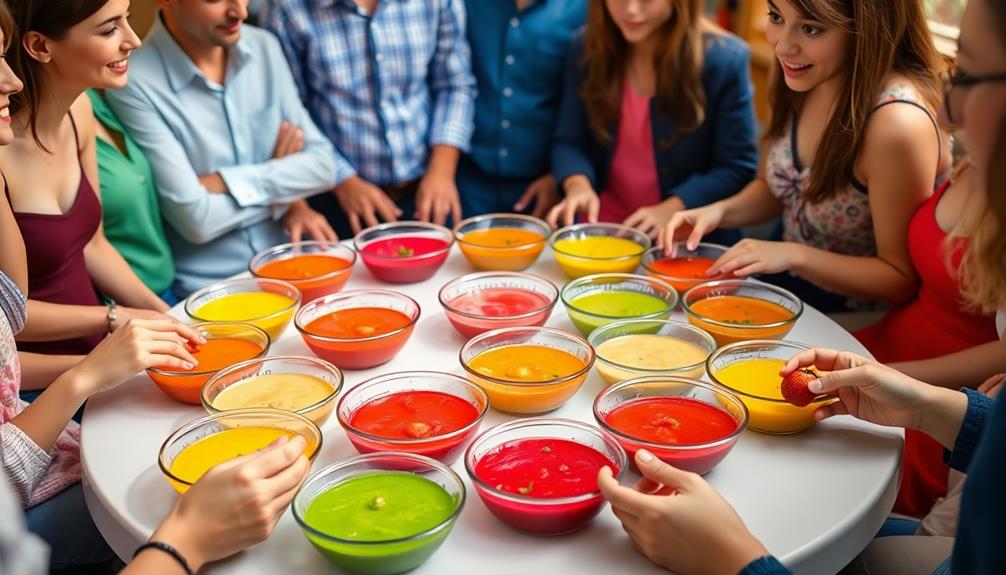
When you see a bright red fruit, you probably expect it to taste sweet and flavorful. Your brain quickly connects color with flavor, influencing how you perceive food quality and taste intensity.
For instance, when presented with a dish like Chilaquiles, the vibrant colors of the green or red salsa may heighten your expectations of its flavor profile.
These visual cues shape your overall experience, making color a powerful factor in your expectations.
Color and Flavor Associations
Many consumers unconsciously associate certain colors with specific flavors, shaping their expectations before even tasting a food item. This phenomenon highlights how color influences flavor perception, often setting the stage for what you anticipate.
Here are four key associations that illustrate this influence:
- Red: Often linked to sweetness, you might expect strawberries or cherries when confronted with red foods.
- Yellow: Typically associated with citrus flavors, such as lemon or banana, leading to expectations of tartness or sweetness.
- Green: Often connected with fresh tastes, such as lime or cucumber, you may perceive a revitalizing flavor profile.
- Orange: This color can be confusing; it's frequently associated with flavors like orange or apricot, but studies show it can be misidentified as cherry.
The saturation and intensity of these colors play a significant role. Brighter colors often lead to anticipations of stronger flavors, while cultural influences can further modify these associations.
Ultimately, understanding these cues can help you navigate your flavor expectations more effectively, ensuring a more enjoyable tasting experience.
Psychological Effects of Color
Colors don't just set the stage for flavor expectations; they also play a psychological role in how you perceive food quality and make choices. When you see vibrant colors in food, your mind automatically associates them with freshness and superior taste. For instance, a bright red fruit often signals sweetness and intense flavor, while dull or mismatched colors, like an orange cherry drink, can confuse your taste perception and diminish your overall experience.
The psychological effects of color extend beyond mere aesthetics. They can trigger your appetite or, conversely, evoke aversion. If you're presented with a plate of colorful, well-arranged food, you're more likely to feel excited about eating. On the flip side, if the colors seem off, you might hesitate, questioning the food quality.
Marketers know this well and often use color additives to enhance the visual appeal of their products, influencing consumer expectations and driving choices.
Ultimately, the colors you encounter can shape your perception of flavor, impacting everything from your cravings to your satisfaction with a meal. So, next time you eat, pay attention to how color influences your experience!
Expectations From Visual Cues
Visual cues, especially color, set the stage for your expectations about flavor long before you take that first bite. Your brain processes these visual signals to shape your taste perception, often leading to strong anticipations based on color alone.
Here are some key ways color influences your expectations:
- Color Association: Bright red foods are often expected to be sweeter than green ones, altering your anticipation of flavor.
- Flavor Confusion: Mismatched colors can lead to misidentification. For example, you might think an orange drink tastes like cherry just because of its hue.
- Color Intensity: Brighter colors typically suggest stronger flavor intensity and higher energy density, influencing your overall sensory experience.
- Psychological Impact: The visual appeal of food can greatly affect food acceptance, sometimes overriding actual taste experiences.
Color Measurement in Food Production
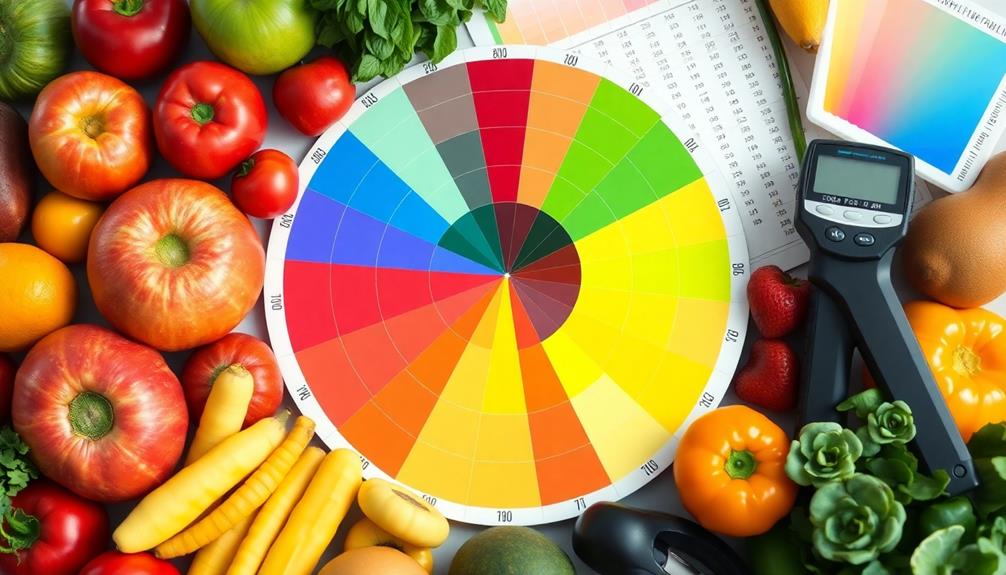
In food production, color measurement plays a fundamental role in meeting consumer expectations and guaranteeing product quality. Color greatly influences perceived taste, making it vital for food manufacturers to adopt advanced spectrophotometric evaluation techniques. These methods provide an extensive analysis of color, which helps maintain brand reputation and product appeal.
Here's a summary of key factors in color measurement:
| Aspect | Importance | Impact on Business |
|---|---|---|
| Color Consistency | Guarantees product uniformity | Boosts consumer trust |
| Consumer Preferences | Adapts to changing color trends | Enhances competitive edge |
| Advanced Techniques | Utilizes diverse optical geometries | Improves accuracy in measurement |
| Cost Optimization | Reduces waste from off-color products | Saves on production expenses |
| Perceived Taste | Links color to flavor expectations | Increases product acceptance |
Age-Related Sensitivity to Color
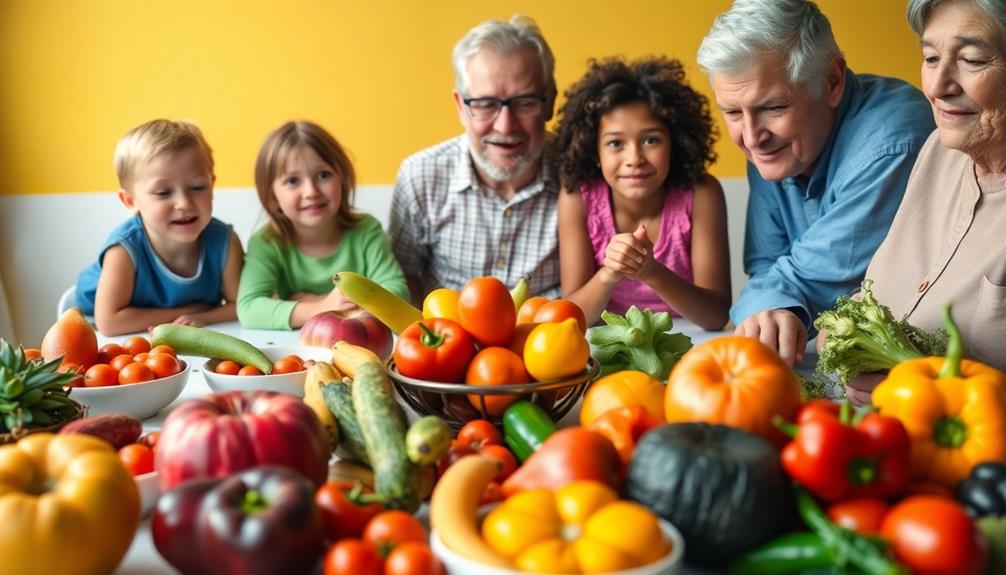
Research shows that age notably influences how people perceive the relationship between color and flavor in food.
Younger adults tend to be more affected by color cues, while older adults exhibit remarkable age-related differences in their taste evaluations. Here are some key points to reflect on:
- Color Sensitivity: Younger individuals often have a heightened sensitivity to food coloring, impacting their flavor perceptions more considerably than older adults.
- Flavor Expectations: As you age, you may rely more on past experiences, leading to different flavor expectations that downplay the role of color.
- Sensory Processing: Age-related variations in sensory processing can alter how you associate colors with flavors, affecting your overall enjoyment of food.
- Taste Perceptions: Older adults may experience discrepancies in taste perceptions, prioritizing other sensory inputs over color when evaluating taste.
These factors suggest that your age can shape how you interpret flavor perceptions, emphasizing the need for researchers to account for age differences in color sensitivity when studying taste evaluations.
As you navigate food choices, it's fascinating to think about how color influences your experience differently than it does for others!
Crossmodal Influences on Flavor
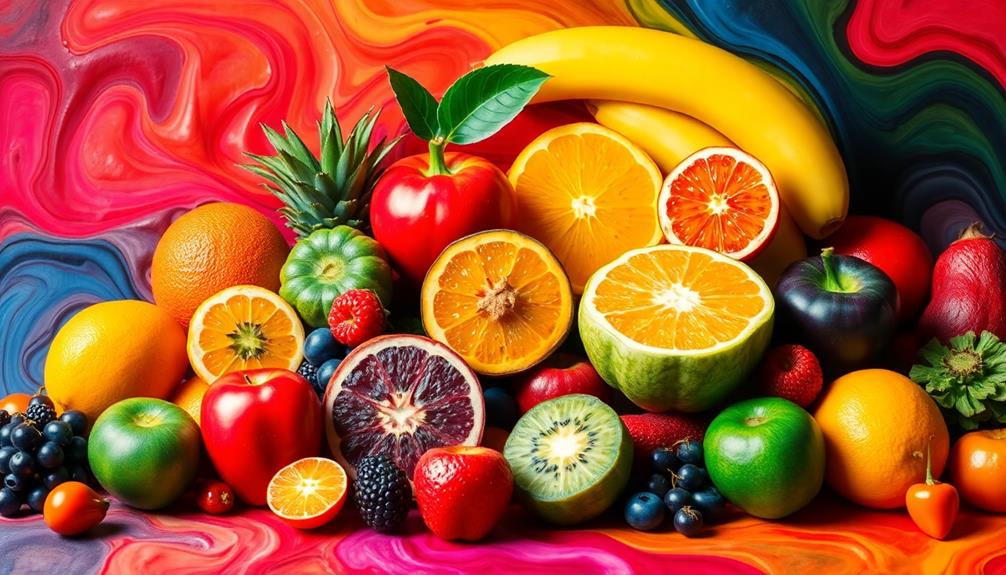
Age-related differences in color sensitivity can greatly affect how you experience flavors, but the interplay between your senses extends even further. Crossmodal influences on flavor perception reveal that the color of food markedly shapes your taste expectations. For instance, you might perceive a bright red cherry drink as sweeter, while darker hues may evoke bitterness. If you encounter a cherry drink that's colored orange, your brain might get confused, leading to misidentification of its flavor.
The intensity of color plays an essential role too; brighter colors often suggest stronger flavors. When you see a vividly colored dish, you might anticipate a more intense taste experience.
Cultural variations also impact how you connect color with flavor; what's sour in one culture could be sweet in another.
Moreover, it's not just about color. The visual properties of food, including its packaging and presentation, can further enhance or diminish your flavor experiences. These factors create a complex web of expectations that influence your overall perception of taste.
Understanding these crossmodal influences can help you appreciate the intricate relationship between what you see and what you taste.
Historical Context of Color Research
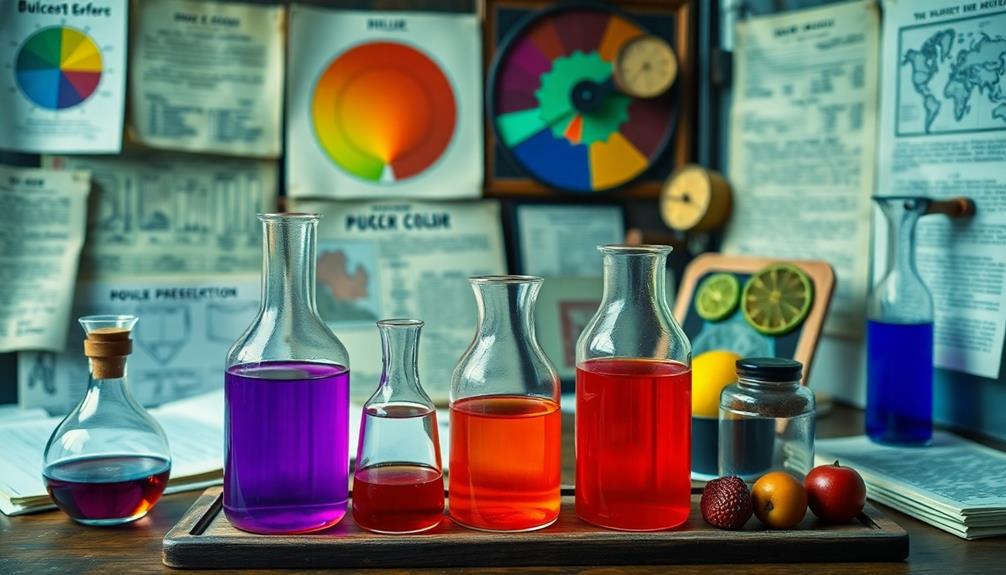
Color has long played an essential role in shaping our perceptions of taste, and the historical context of color research reveals this fascinating evolution. The journey began with H. C. Moir's groundbreaking report in 1936, which sparked interest in how food color affects flavor perception.
Here are some key milestones:
- Artificial Food Coloring: Early debates highlighted the butter industry's resistance to yellow margarine, citing authenticity concerns.
- Consumer Reactions: Mid-20th century studies showed that unusual food colors greatly influenced taste expectations, altering how you perceive flavor.
- Crossmodal Correspondences: Research evolved to explore how color associations affect consumer perceptions, emphasizing the interplay between sight and taste.
- Marketing Strategies: Over time, food marketing adapted, leveraging color and its impact to enhance appeal and boost sales.
These historical perspectives illustrate how the cumulative findings from decades of research underscore the critical role of food color in consumer choices.
Understanding this evolution not only enriches your knowledge but also informs how you approach food, whether in your kitchen or while shopping.
Practical Applications in Marketing
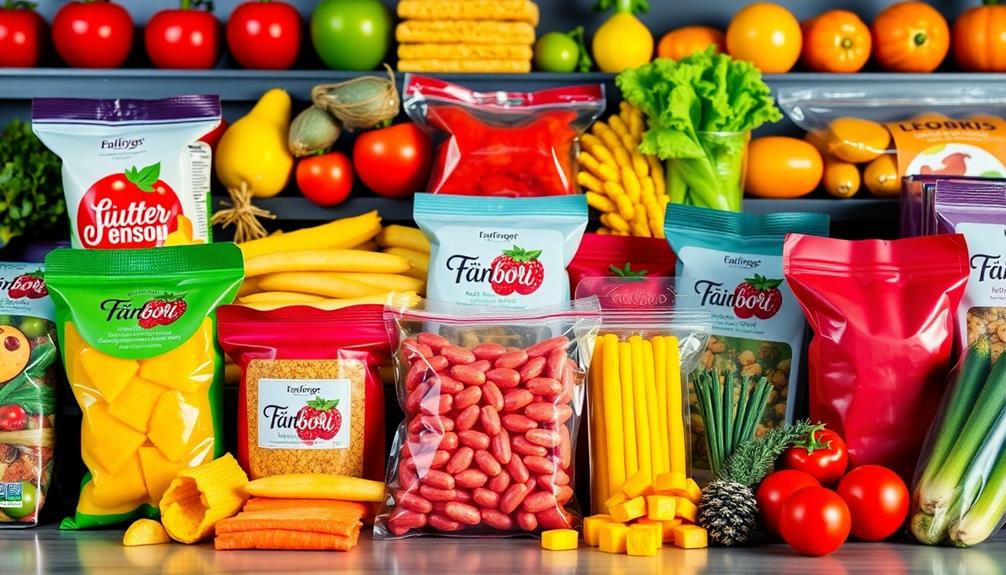
In the domain of food marketing, the strategic use of color can make or break a product's success. Brightly colored packaging often enhances consumer expectations of flavor, especially when it comes to food and beverage items. When you employ vibrant colors, you're tapping into associations that suggest sweetness, leading to higher acceptance and preference.
Visual appeal is essential; consumers are more likely to purchase products that catch their eye. However, mismatched colors between the product and its packaging can negatively impact flavor perception. This highlights the importance of aligning color cues with expected flavors in your marketing strategies. If your packaging color doesn't match what consumers anticipate, you risk losing their trust and interest.
Moreover, color choices can evoke strong emotional responses, influencing not just perceptions but also purchase decisions. Advanced technologies, like spectrophotometric evaluation, can help guarantee consistency in packaging color, which is key for meeting consumer expectations.
Frequently Asked Questions
How Does Color Affect Taste Perception?
Color affects your taste perception by shaping your expectations before you even take a bite. Bright colors often signal sweetness, while dull hues can create confusion, leading you to misidentify flavors or judge food quality.
Does Food Colouring Affect Flavour?
Yes, food coloring does affect flavor. You'll find that vibrant colors can make dishes seem more appealing and flavorful. Your expectations shift based on color, influencing your overall enjoyment of the food you're tasting.
Why Is the Perception of Color in Food Important?
When you see food, color immediately grabs your attention, doesn't it? That's why the perception of color in food's so important—it shapes your expectations, influences your choices, and impacts your overall dining experience.
How Does Color Affect Perception?
Color shapes your perception by influencing your expectations and emotions. When you see vibrant hues, you might anticipate certain flavors, often overriding your actual taste experience. Consequently, your enjoyment can hinge on these visual cues.
Conclusion
In the vibrant tapestry of our culinary experiences, color dances hand in hand with flavor, shaping how we savor every bite. You've seen how our brains weave together hues and tastes, crafting expectations that can enhance or diminish our enjoyment. As you explore your next meal, remember that colors aren't just visual delights; they're subtle puppeteers, pulling the strings of your palate. Embrace this colorful symphony, and let it elevate your culinary adventures to new heights.
